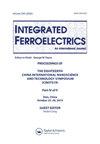取向晶界附近BNLT-BT陶瓷的相变、热膨胀和电性能
IF 0.7
4区 工程技术
Q4 ENGINEERING, ELECTRICAL & ELECTRONIC
引用次数: 0
摘要
摘要采用改进的两步混合氧化法制备了钛酸铋钠(Bi0.4871Na0.4871La0.0172TiO3: BNLT)和钛酸钡(BaTiO3: BT)基无铅陶瓷。研究了BT含量对无铅BNLT-BT陶瓷的相变、热膨胀行为、力学和电学性能的影响。根据热膨胀数据估计了燃烧的温度和局部极化。对该体系的极化行为和其他效应的认识也进行了研究和讨论。0.96BNLT-0.04BT陶瓷的d33值为135 pC/N。其矫顽力场(Ec)和剩余极化(Pr)分别为24 kV/cm和9.0µC/cm2。这对未来电子应用中多功能无铅材料的开发具有重要意义。关键词:热膨胀介电性能铁电性能电学性能致谢作者要感谢泰国Rajamangala理工大学理学院、应用物理系、理学院和文理学院的资助。N. Pisitpipathsin也感谢泰国研究基金(TRF) (TRG6280011)和泰国Nakorn Ratchasima同步加速器光研究所(公共组织)的支持。此外,UTSA感谢NSF/INAMM拨款#0844081的支持。披露声明作者未报告潜在的利益冲突。本文章由计算机程序翻译,如有差异,请以英文原文为准。
Phase Transition, Thermal Expansion and Electrical Properties of BNLT-BT Ceramics Near the Morphotropic Phase Boundary
AbstractLead-free ceramics based on bismuth sodium lanthanum titanate (Bi0.4871Na0.4871La0.0172TiO3: BNLT) and barium titanate (BaTiO3: BT) were prepared by a modified two-step mixed-oxide method. Effects of BT content on the phase transition, thermal expansion behavior, mechanical and electrical properties of lead-free BNLT-BT ceramics were studied. The Burn’s temperature and local polarizations were estimated from the thermal expansion data. Various aspects of understanding the polarization behavior and other effects in this system have also been investigated and discussed. The 0.96BNLT-0.04BT ceramics have shown the d33 value of 135 pC/N. The coercive field (Ec) and remanent polarization (Pr) were found to be 24 kV/cm and 9.0 µC/cm2, respectively. This may be useful in the future development of multifunctional lead-free materials in electronic applications.Keywords: Thermal expansiondielectric propertiesferroelectric propertieselectrical properties AcknowledgmentsThe authors would like to thank the Faculty of Science, Chiang Mai University, Department of Applied Physics, Faculty of Sciences and Liberal Arts, Rajamangala University of Technology Isan, Thailand for financial support. N. Pisitpipathsin also appreciated the support from the Thailand Research Fund (TRF) (TRG6280011) and Synchrotron Light Research Institute (Public Organization), Nakorn Ratchasima, Thailand. Also, the UTSA acknowledges the support of NSF/INAMM grant #0844081.Disclosure StatementNo potential conflict of interest was reported by the author(s).
求助全文
通过发布文献求助,成功后即可免费获取论文全文。
去求助
来源期刊

Integrated Ferroelectrics
工程技术-工程:电子与电气
CiteScore
1.40
自引率
0.00%
发文量
179
审稿时长
3 months
期刊介绍:
Integrated Ferroelectrics provides an international, interdisciplinary forum for electronic engineers and physicists as well as process and systems engineers, ceramicists, and chemists who are involved in research, design, development, manufacturing and utilization of integrated ferroelectric devices. Such devices unite ferroelectric films and semiconductor integrated circuit chips. The result is a new family of electronic devices, which combine the unique nonvolatile memory, pyroelectric, piezoelectric, photorefractive, radiation-hard, acoustic and/or dielectric properties of ferroelectric materials with the dynamic memory, logic and/or amplification properties and miniaturization and low-cost advantages of semiconductor i.c. technology.
 求助内容:
求助内容: 应助结果提醒方式:
应助结果提醒方式:


